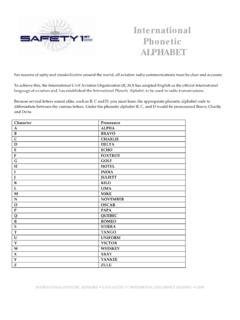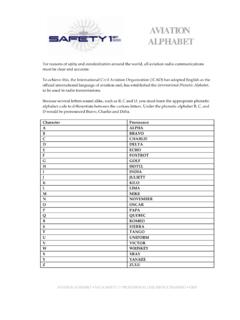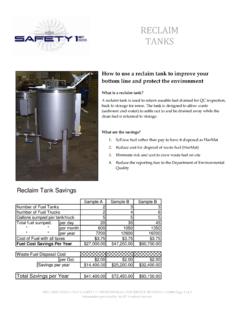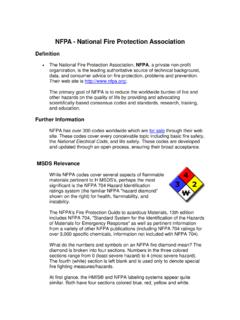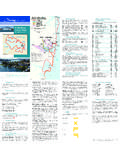Transcription of Towing Walk Around Inspection - natatraining.com
1 Pre- Towing walk - Around : NATA Safety 1st Professional Line Service Training Page 1 of 2 8/22//2007 Towing Inspection walk Around Prior to moving any aircraft you must perform a walk - Around of the aircraft to determine if the aircraft is ready to move, that the area is clear of obstacles, and to be certain that there is no prior damage to the aircraft you are planning to tow. After correct placement of the tow-bar, or attachment of the tug to the aircraft, you must perform the following walk - Around safety check. Remember; never remove the wheel chocks until the aircraft is firmly attached to the tow vehicle. Note: If you find any damage to the aircraft or any situation that does not look correct, check with your supervisor and report it immediately prior to moving the aircraft.
2 Start at the left side of the nose of the aircraft (the pilots left) Check to see that the nose wheel is inflated properly Check the nose wheel strut is not flat against nose collar and look for any leaking hydraulic fluid. If the aircraft has wheel coverings (wheel pants) check for damage or paint scratches Check the cowling for damage to cowl flaps or other engine openings Check to be certain that the tow-bar will clear the propeller when tow-bar is turned walk along the left side of the aircraft towards the left wing looking for any damage to the aircraft including under the fuselage Be sure all passenger entry doors are closed and secure Look for any broken or damaged antennas, pitot tubes or other small extremities of the aircraft walk along the front of the left wing inspecting the entire leading edge If the aircraft is secured by tie-down, disconnect the tie down cables of the left wing Remove any chocks from the left main wheel(s)
3 At this time Check for damage to the left main gear including wheel covers, struts, tire inflation and hydraulic or brake fluid Inspect the left wing tip for damage including any static wicks, winglets and the red position light\ At this time look Around the area to see that the left wing is clear of any obstructions and that it is clear to move forward maintaining adequate clearance. Move along the entire trailing edge and control surfaces of the left wing and inspect for damage including damaged static wicks. walk along the left side of the empennage towards the tail and look for damage including under the aircraft Be sure all aircraft cargo/baggage doors are closed and/or secure Inspect the leading edge of the left horizontal stabilizer Inspect the tip of the left horizontal stabilizer Check the trailing edge of the left horizontal stabilizer including static wicks walk along or under the horizontal stabilizer stopping at the center to inspect the tip of the tail including static wicks and the white position light Pre- Towing walk - Around .
4 NATA Safety 1st Professional Line Service Training Page 1 of 2 8/22//2007 If the aircraft is secured by a tail tie-down cable, remove it at this time Check for a rudder or gust lock handle or attachment at the rear of the empennage. The gust lock must be removed or in the disengaged position prior to Towing From the rear of the aircraft, look forward and be certain that the area under the aircraft is free from tools, jacks, wing and tail stands, carpets, or other items Around the aircraft. Remove all items from under the aircraft prior to the Towing operation Check the trailing edge of the right side of the horizontal stabilizer including static wicks Inspect the right tip of the right horizontal stabilizer Check the leading edge of the right horizontal stabilizer Move along the right side of the empennage and inspect for damage including under the aircraft Check the trailing edge of the right wing including the control surfaces and static wicks Disconnect the right wing tie down cables Remove the wheel chocks from the right main landing gear Inspect the right main landing gear for damage including air strut, wheel coverings.
5 Hydraulic and brake fluid and tire inflation Inspect the right wing tip including static wicks, winglets and the green position light Make sure that the right wing is clear of any obstructions in the direction of the Towing operation Move along the entire leading edge of the right wing and inspect for damage Check the right side of the nose of the aircraft including cowlings, pitot/static systems or other aircraft extremities Make a final check of the area for clearance, and use a wing walker when necessary Make a final check of the tow-bar and the tow vehicle prior to moving the aircraft If the aircraft will not move easily, check with the flight crew for brake release Tow the aircraft slowly, no faster that a person can walk , and keep the aircraft well clear of all obstructions including vehicles and other aircraft at all times If distracted at any time during the walk - Around or Towing sequence stop and wait before proceeding.
6

